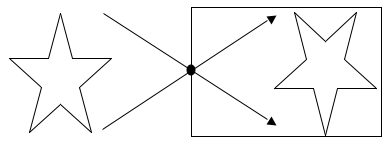Light and Optics: Personal Pinhole Theater
[Shopping List: pre-made pinhole theaters; thumbtacks; black duct tape; black electrical tape; dark colored towels]
- Place the theater box over the kid's head, making sure that the hole is on the wall of the box that touches the back of his/her head. Place a dark towel around their shoulders to block out any extra light.
- Direct the kids to look up (they will want to look straight ahead at the wall of the box, but the image is on the wall above their eye level).
- If they cannot see anything, point them at the sun – it is difficult to miss! Then gradually help them to focus on something else, like another kid, or a building, or a tree.
- Some of the theaters have two holes in them – start with one hole covered so that the kid sees only one image, and then uncover the second hole so that two images are visible.
* Repair the theaters as needed – if a hole is poked in one accidentally, cover it with black tape to prevent excess light from entering.
What's Happening: When you see an image on the inside of the pinhole theater, it is the upside down, backwards image of something located behind you. The image is that of something behind you because the only place where light can enter the box is a pinhole located behind your head – the light enters through this hole, continues traveling in a straight line, and then shines on the opposite side of the box. A pinhole is special in that it limits the number of rays of light that pass from a given object onto a screen or piece of film; only one ray of light originating from each point on the image can fit through the hole. Light rays reflect off an object at an angle (see diagram below) and, since rays of light travel in straight lines, will continue moving in the same direction after entering the pinhole. Consequently, rays that reflected off the right side of the object at an angle moving to the left will end up on the left side of the screen and rays reflected off the top parts of the image end up at the bottom of the screen.

The image you see is upside down and backwards.
A small hole gives a sharper focus to the image, because it limits the rays of light observed from each point on the object. However, images formed using small holes are also very faint and hard to see exactly because not enough light is let through to see the image. An image formed using a larger hole is easier to see, but much blurrier.
Just like the pinhole theaters, the images formed on the back of our eyes are upside down. We do not interpret them as such, however, because the brain instinctively reverses the image. |